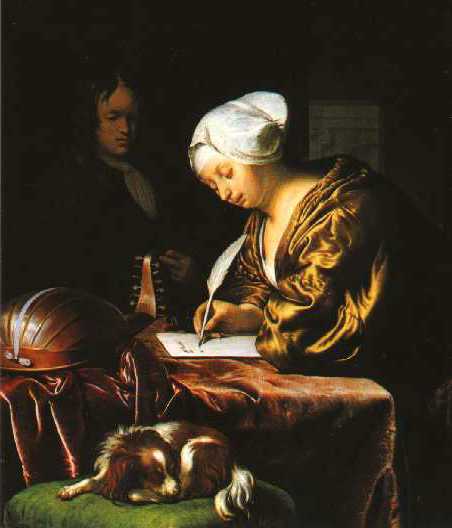

Frans van Mieris (1635 - 1681)
Woman writing a letter
Rijksmuseum, Amsterdam
|
Frans van Mieris was born and worked all his life in Leiden. Apprenticed as a goldsmith, he later briefly became a pupil of the famous glass-painter Abraham van Toorenvliet before apprenticing himself to Gerard Dou who referred to van Mieris as "the prince of his pupils". Next he studied with the history and portrait painter Abraham van den Tempel before returning to complete his studies with Gerard Dou.
He entered the Leiden Guild of St. Luke [the painters' guild] in 1658 and served as leader in 1663 and 1664 and dean in 1665.
He was extremely popular as a portrait painter to Leiden's wealthiest citizens. He received commissions from Grand Duke Cosimo III de Medici and Archduke Leopold Wilhelm who unsuccessfully offered him a place as court painter in Vienna. However he seems to have been an habitual drunkard and constantly in debt, even though he was well enough respected to be buried alongside prominent Leiden citizens in the Pieterskerk on his death in 1681.
This picture may be a portrait of his wife, by whom he had 5 children. The dog in the foreground is a symbol of marital fidelity and the lute is often also used as a symbol of domestic harmony, a life in tune with itself. Ironic when one considers the many complaints about how difficult it is to keep a lute in tune! With symbols such as these, we must assume she is writing to her mother rather than her lover; especially with the shadowy figure of a man, presumably her husband, looking on!
Like Gerard Dou and other 17th century Dutch painters, he often included musical instruments, and particularly lutes, in his paintings. It is from paintings such as this one that we can tell how important the double-headed 12 course lute was in the Netherlands at this time.
To be sure, I cannot see the extended second pegbox on this lute but the characteristic curved main pegbox which shows up so clearly is almost proof enough. I have never seen a picture of a 17th century lute with curved pegbox which wasn't a double-header [though the converse is not quite true]
There are only 13 pegs visible but this type of lute usually had a treble rider for the chanterelle and, with a single second course, it could thus have the normal 8 courses on the fingerboard leaving 4 stepped courses for the upper pegbox.
The ribbon tightly tied along the back from a button on the endclasp to another on the neckblock is another common feature of lutes of this and later periods. It seems to have been a playing aid to be hooked on a button in the clothes to stabilise the notoriously slippery lute. Certainly several surviving lutes in museums have the buttons and in some cases either the string, usually of gut, or at least grooves in the varnish showing where it was tightly tied.
The light line on the lower edge of the endclasp may be the edge of the soundboard but it is rather thick for that and it may possibly represent a narrow lace of parchment. This is slightly confirmed by the aged appearance of the varnish of the back, suggesting a conversion of an old lute, as became fashionable in the 17th century. For these conversions a parchment lace often served to cover and protect the worn edge of an old soundboard.
What is unusual is the ridged appearance of the rib joints. This is more than the normal cupping of the broad ribs which leaves the joints prominent. This appears to be an actual ridge between each rib. Such ridges are, uniquely to my knowledge, present on the back of the Martin Hoffmann German baroque lute in Nürnberg. It has been suggested by some that they are a consequence of shrinkage of the lining tapes glued along the inside of the rib joints. However careful analysis of the geometry of the joint and its tape will show that this is impossible without opening up the joint itself into an open V. No, these ridges must have been carved into the edge of each rib, an enormous undertaking! So far as I know only one modern maker, Frank Bormann of Denmark, has tried to copy this feature on a regular basis.
|
| Since this appeared Stewart McCoy has drawn my attention to his letter in Early Music, vol 4, No. 2 April 1976 where he outlined this system of supporting the lute and quoted Mersenne’s remark in his Traité des Instrumens a Chordes (Seconde Partie de l’Harmonie Universelle, Paris, 1637) p. 77: “the lute, leaned against a table or another body, must be supported by the weight of the right arm, although one can hold it without this prop by means of two small buttons of ebony or ivory”. (Trans, R. E. Chapman, The Hague, 1957, p. 105.) |
|
If anyone has any comments about these pictures which differ from or expand
on mine, please do either email me direct or submit them to the lutenet at antispam/lute@cs.dartmouth.edu and I will add them to this page. Do please adjust this address by hand to remove antispam/ |
| Lutes | Bows | |
| History of the Lute | Build your own Baroque Lute | Build your own Renaissance Lute |
Copyright 2000 by David Van Edwards